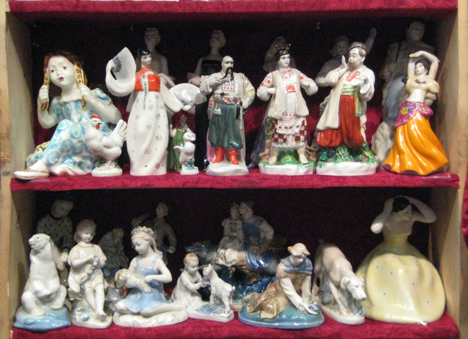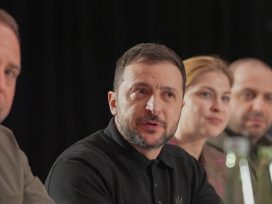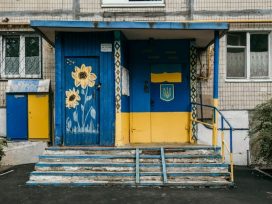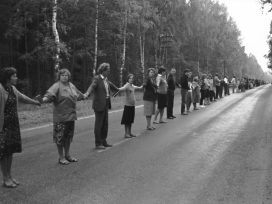"Us" and "Them"
Post-Soviet migration in Russia and (re)making symbolic boundaries
Researchers have been too quick to accept the premise that Russia is the second largest immigration state (after the United States). An uncritical stance towards this assertion leads us to ignore the specificities of the post-Soviet context of migration processes. In this context, the phenomenon referred to as “immigration” is, to a significant degree, the same thing as geographic mobility within the bounds of the former USSR. The people that belong to the two sides of this process that are referred to as host society and immigrants were until recently part of the same political and cultural community. What we have observed in the last quarter century is the process of becoming alien, of othering those who, in the memories of generations still living today, were either entirely or partially “ours”. In other words, we are witnessing an about-face in the process of constructing and reconstructing symbolic boundaries, which affects different groups in different ways.
According to the common conception, an immigrant is a person who lives in a different country from the one in which he was born. On this basis, international organization officials determined in the early 2000s that Russia has the second-highest number of immigrants in the world.1 Did employing the term “immigrant” in this way not play a mean joke on us? The fact is, many of those who were considered immigrants for statistical purposes in the 2000s were born in the very country where they reside today: the USSR. They were from Ukraine, Kazakhstan, Azerbaijan, etc.2The issue is not even that many of them were ethnic Russians, but that these displaced people were not fundamentally different (if they were different at all) from the “host society”, with regards to self-identification, culture, or education (Malakhov 2016).
Only a very small percentage of those who moved to Russia between 1989 and 2002 (the interval between the last Soviet and first post-Soviet censuses) came from countries outside the borders of the former Soviet Union (Korobkov 2008:69-70). These 50 thousand people were, for the Russian case, immigrants in the true sense of the word. Thus, the case of post-Soviet Russia does not fit the model of post-colonial migration, based on the examples of the United Kingdom, France, and the Netherlands.
Post-imperial condition: From fellow citizens to foreigners
In December 1991, the former Soviet people – “Soviet” not only in terms of citizenship, but also in terms of self-identification – became foreigners to each other. Individuals who had felt they belonged to the same political and communicative space began to become aliens.

Soviet porcelain. Photo: shakko. Source: Wikimedia
This is what makes the Russian case unique when compared to other “post-imperial”/ “postcolonial” situations.3 Immigrants from former colonies (from the Indian subcontinent to the UK, from the Maghreb to France, from Suriname and Indonesia to the Netherlands) were largely alien to the population of the former metropolitan centres. The newcomers were perceived by the local population (and perceived themselves) as “other” in terms of culture and in terms of personal and collective identities. They did not belong there. They might have been subjects of the Empire de jure (or even semi-citizens, as was the case for Algerians in France), but de facto they were not part of a common socio-cultural space. They were separated from the host population by firm boundaries. Nowadays these boundaries have become less impermeable. (This is referred to as “integration”.)
In the case of post-Soviet migrations into Russia, the dynamic of symbolic boundaries seems to unfold in the opposite direction. Symbolic boundaries that were once fairly permeable are becoming more rigid. We are witnessing a process of “othering” – the transformation of those who a mere quarter century ago considered each other “ours” into “others”.
By no means do I intend to idealize the Soviet experience. I do not claim that there were no interethnic tensions within society; nor do I underestimate the cultural heterogeneity of the so-called “Soviet people” (a fortiriori, given that the communists in Moscow promoted cultural diversity, provided that it was not in conflict with political loyalty – i.e., loyalty to the regime).
What I am arguing is that there was a space for communication – a socio-cultural space – common to Soviet citizens regardless of their place of origin.
Identity is a tricky issue, a vague issue. Nobody can be certain what the “real” identities of individuals are, or what the real identities of individuals under the Soviet regime were; some of them were even ideologically anti-Soviet, but culturally Soviet – think of Alexander Galich or Bulat Okudzhava. For some of them, their ethnic belonging mattered more than their citizenship (often the case for non-Russians). This is not the point. The point is that, regardless of these differences, there was a common communicative space – based on a common culture4 – in which everyone was supposed to take part.
And nowadays this space is evaporating.
“Us” and “Them” in today’s Russia: Drawing and re-drawing symbolic boundaries
Distancing himself from the newcomers, the Russian Everyman prefers to legitimate his standpoint in “ethnic” terms: he argues that it is ethnicity that makes the immigrants different. Why is it “ethnicity” that does this, and not language or religion?
Language does not play this role because many post-Soviet migrants in the 1990s spoke Russian as fluently as Russians themselves. For many of them it was a mother tongue. This was the case not only for Belarusians, eastern Ukrainians and many Moldovans, but among Kyrgyz from Bishkek and the majority of urban Kazakhs.5 Nor does religion, because the majority of migrants were as religiously indifferent as the local population. In the perception of ordinary Russians, there was no difference between Armenians and Georgians, on the one hand, and Azerbaijanis, on the other hand – even though the former are nominally Christians, and the latter Muslims. All three of them are lumped into a single group: “khachi”,6 “blacks”, “black asses”, “individuals of Caucasian origin”. At the same time, one of the quasi-racial categories used to designate those from the Caucasus – “blacks” – is used to designate newcomers from Central Asia as well.
Thus, in this context “ethnicity” is an empty signifier. It might mean “race” (physical appearance), “culture” (certain patterns of behaviour), social role or social status. Some post-Soviet migrants are strongly associated with trade and small business (mainly those from the South Caucasus), others with low-paid and undervalued positions in construction and in the housing and utilities sector (primarily from Central Asia).
Be that as it may, ethnicity is a marker of “alienness”, of not-belonging-here. However, two points ought to be made in this regard. First, this “alienness” is very uneven, if not erratic. Second, along with newcomers from states of the former Soviet Union (FSU), there are other aliens – immigrants from outside the FSU.7 In other words, there are different levels of being alien in contemporary Russia.
We can distinguish three dimensions of this phenomenon: legal, political, and socio-psychological.
Russia’s Others in legal terms
From the legal point of view, there is only one distinction that exists among foreigners in contemporary Russia: whether they come from countries that have established a visa regime with Russia, or from countries whose citizens can enter Russia without a visa.8 With the exception of Turkmenistan and Georgia, all the countries that emerged after the collapse of the USSR have visa-free regimes. (It goes without saying that the three Baltic states, as EU members, have a visa regime with Russia.)
So, legally, there is no difference between immigrants from, say, Georgia or Turkmenistan and immigrants from, say, Germany or France. But there is a huge difference politically and psychologically.
In speaking about the legal aspect of this question, it is also worth mentioning one curious circumstance: in contemporary Russian legal discourse, the concept of “immigrant” does not exist. If political and public discourses teem with discussions of the topic of immigration and immigrants, representatives of the law do not recognize these categories. They rely on the concepts of “foreigner,” “foreign citizen,” and “foreign worker.” In this regard, the Russian situation is reminiscent of France or Germany, in contrast to the UK and the US. In France, there are officially only two categories of residents: citizens and foreigners (citoyens/strangers). From the moment a migrant acquires French citizenship, he becomes “French”. In Germany, for a long time the concept of “migrant” did not exist in official terminology (although for different reasons than in France).9 Migrants, including those who had lived in Germany for 10-15 years or more and their children, were called “foreigners” (Ausländer), while migrants of German origin, even if they did not speak German, were called “emigrants” (Aussiedler). In contrast, in the United Kingdom, everyone who comes to the country for a long period of time or with the goal of permanent residence is called an “immigrant”, and in common parlance there is even a difference made between them and “migrants”, people who have come to Britain for a short period of time.
These linguistic differences are telling, as they express the expectations that predominate in society. If in France new arrivals were expected to assimilate to the French nation as quickly as possible (hence the French reluctance to use the term “second generation” of migrants), and in Germany – at least until the law on citizenship was revised in 1999 – to “return to their homeland” (hence the term Gastarbeiter), in the Anglo-Saxon world a more pragmatic attitude towards newcomers dominated.10 The fact that in the past decade the word “Gastarbeiter” has entered and been adopted by the Russian language is also telling. Both the general public and a significant segment of the elite are not prepared to accept the notion that Russia is becoming a country of immigration (Malakhov 2014).
Russia’s Others in political terms
On the political level, there is a clear dividing line between the so-called “far” and “near” abroad. As can easily be guessed, the near abroad includes all FSU countries, while the far abroad comprises everywhere else. (An interesting case is presented by the three Baltic countries, which – despite their membership in the EU and NATO – belong to the “near abroad”.) Again, if we look at the matter from a purely formal perspective, politically there are no distinctions made among people coming from the countries of the “far abroad”. But in fact, within the category of “far abroad”, there is a certain differentiation, which can be thought of as “the West and the Rest”. Immigrants from, say, the US or Switzerland are one thing; immigrants from Vietnam or South Korea are quite another. It is unlikely that Russian officials will allow themselves to violate the law (or even display impoliteness) towards the first group, but it is very possible for this to happen towards the second group. And the issue is not racism, but primarily the fact that the positions held by immigrants from first world countries are, as a rule, “HQS” (highly qualified specialists): financial experts, managers, theatre directors, football coaches, etc. Meanwhile, immigrants from the third world are mainly employed in low-pay, low-prestige jobs.
Russia’s Others in socio-political terms
What is most fascinating is how the “otherness” of newcomers is understood on the level of common consciousness. It makes sense to distinguish between two levels of “otherness” among migrants: whether they are other by dint of their citizenship (foreigners) or other in terms of belonging to a different imagined community (aliens). As a result, we can think of six different groups.
The first is Aliens/Foreigners. They are alien both in the ethno-cultural sense and in the political and legal sense. This group includes people from Asia and Africa. Here we have full-blown otherness: Asians and Africans do not belong here (i.e., in Russia). They are other in every way. (And not least because of their race.)11
The second group is Semi-Aliens/Foreigners. These people come from EU countries and from North America. Their political and legal otherness is unquestionable, but they are not seen as being as alien as Asians and Africans. In ethno-cultural terms they are much like “us”.
The third group is Aliens/Semi-Foreigners. In this group are people from Central Asia. They are not 100 per cent foreigners, because the sovereignty of their home countries is seen as conditional (hence the Russian proverb “A chicken is not a bird, Kyrgyzstan is not abroad”), but they are completely “other” or alien in the ethno-cultural sense.
The fourth group is Semi-Aliens/Semi-Foreigners. This includes people from post-Soviet countries like Moldova, Armenia and (until the war in 2008) Georgia. They are not entirely foreigners for the same reasons as citizens from other “near abroad” states, but they are also not entirely “culturally” alien.12
The fifth group is Non-Aliens/Semi-Foreigners. These are Belarusians and (until recently) Ukrainians. Not only is their otherness by way of citizenship questionable, but it is believed that these are “our people” from a cultural and ethnic point of view (according to a commonly held myth, Belarusians and Ukrainians are part of the same nation as Russians).
Finally, the sixth group is Non-Foreigners/Semi-Aliens. In this group are Chechens and other people from the North Caucasus, who are Russian citizens, but who are psychologically alienated from the main population of Central Russia and Siberia, where they travel for work. More than once, reports have appeared in the press that the residents of some region of Siberia or Central Russia have demanded that the authorities “deport” Dagestanis or Chechens – that is, as the initiators of these demands put it, send them back to their “country of origin”.
The dynamics of symbolic boundaries
Of course, the boundaries described above are highly moveable. Even in describing them we were forced to make provisos, in order to note shifts in public perception that have occurred under the influence of factors that are primarily (geo)political. Before the events of 2014, Ukrainians were considered “brothers,” who held different passports only through a series of historical coincidences. The border between Russia and Ukraine was not seen as something as serious as, for example, the border between Russia and China. Over the course of the war in south-eastern Ukraine, however, attitudes have changed so dramatically that Ukrainians (with the exception of the population of the self-declared Donetsk and Luhansk People’s Republics) have transformed in the eyes of the average Russian not only into “others” in both senses of the word (political and cultural), but even into enemies. To the extent that the conflict has been pacified, the Russian media’s intonation softened, but it is clear that Ukrainians will never again be perceived psychologically on the same scale as Belarusians.
In a similar fashion, before Mikheil Saakashvili came to power in 2003, Georgians were presented in the Russian media machine (and were correspondingly understood by the average person) as holding a similar position to Armenians and Moldovans today. The subsequent cooling of relations with Georgia, followed by the war in August 2008, substantially changed attitudes towards Georgians. They are now clearly more “other” than they were in the first decade and a half after the end of the Soviet era.
Very indicative are the shifts in symbolic boundaries in the case of Eastern Europe, which until 1989 fell under the orbit of Soviet influence. The members of the “socialist camp” were perceived differently from one another as far back as the era of Brezhnev and Andropov. For example, on the scale of fraternality, in mass perception Bulgaria fell closest to the Soviet republics within the USSR (it was even jokingly referred to as the “sixteenth republic”, and the above-cited proverb that now features Kyrgyzstan then referred to Bulgaria). A little more than two decades later, the difference between this country and, for example, Poland and Hungary has virtually disappeared. Moreover, a quarter century has proven to be sufficient for the average Russian to get used to the idea that East European states are fully sovereign. On the psychological level, today people from the former “Second World” are grouped with newcomers from the former “First World” – Aliens/Foreigners.
And yet again, within this group there are some foreigners who are “less alien” than others: Serbs and Greeks. In the case of Serbia, the narrative of Slavic brotherhood has been preserved. Since Serbia is moving towards joining the EU, however, this narrative will most likely lose its significance. (As is already happening with Montenegro.13) Greece, although a NATO member, occupies a particular place in the Russian political imagination because it is an Orthodox country.14
An ambivalence towards the three Baltic states remains. Since they became members both of the European Union and NATO back in the 2000s, the question of their sovereignty is seemingly settled.15 Russians had to come to terms with the fact that people from these countries are complete foreigners; back in Soviet times, they had already gotten used to considering them aliens in a certain sense.16 At the same time, this region is affected by what is called the “compatriot problem” in Russia.17
Attitudes towards Turkish citizens have been evolving in an interesting way. First, in contemporary Russia, Turks comprise a fairly numerous cohort of construction workers and businessmen who captured the Russian market as early as the turn of the twenty-first century.18 Second, they are often business partners or, at a minimum, the inviting company of those Russian citizens who amassed their first capital thanks to trips to Turkey in the 1990s (primarily, but not only, shuttle traders19). People from Turkey, in principle, fall into the second of the above-mentioned groups (despite the fairly obvious cultural differences between them and Europeans). Popular conceptions, however, underwent a fundamental change in fall 2015, after a Russian plane was shot down near the Turkish-Syrian border. Over the course of several weeks, the media spun things in such a way that the image of Turks in the eyes of normal Russians came to be associated more with the Russo-Turkish wars of the nineteenth century than with dynamic business and increasingly high-quality products.20
There is no doubt that as the political and economic situation continues to change, so will the stereotypes of “Others”.
References
Abashin, S. (2014) Nations and Post-Colonialism in Central Asia; Twenty Years Later. In S. Hohmann, C. Mouradian, S. Serrano, & J. Thorez (Eds.), Development in Central Asia and the Caucasus: Migration, Democratisation and Inequality in the Post-Soviet Era (Vol. 70). IB Tauris.
Brubaker, R. (1992). Citizenship and nationhood in France and Germany. Cambridge, MA: Harvard University Press.
Burbank, J. (2006). An imperial rights regime: Law and citizenship in the Russian Empire. Kritika: Explorations in Russian and Eurasian History, 7(3), 397-431.
Demintseva, E. (ed.) (2013). Rasizm, ksenofobiia, diskriminatsiia. Kakimi my ikh uvideli. Moscow: Novoe literaturnoe obozrenie. Fierman, W. (2005). Kazakh Language and Prospects for its Role in Kazakh” Groupness”. Ab Imperio, 2005(2), 393-423.
Florinskaia, Iu. F., Mkrtchian, N.V., Maleva, T.M., Kirillova, M.K. (2015). Migratsiia i rynok truda. Moscow: Izdatel’skii dom “Delo”.
IOM. (2008). Migration in the Russian Federation: A Country Profile 2008.
Kirkwood, M. (1991). Glasnost’ “the national question” and Soviet language policy. Europe-€Asia Studies, 43(1), 61-81.
Korobkov, A. V. (2008). Post-Soviet migration: new trends at the beginning of the twenty-first century. In C. J. Buckley & B. A. Ruble, with E. T. Hofmann (Eds.), Migration, homeland and belonging in Eurasia (pp. 69-98). Woodrow Wilson Centre Press.
Malakhov, V. S. (2014). Russia as a New Immigration Country: Policy Response and Public Debate. Europe-Asia Studies, 66(7), 1062-1079.
Malakhov, V. S. (2016). The Phenomenon of New Immigration Countries: Russia’s Case in the European Context. In M. S. Rosanova (Ed.), Labour Migration and Migrant Integration Policy in Germany and Russia (pp. 11-23). St. Petersburg: Saint-Petersburg State University, Skythia-print.
Tlostanova, M. (2012). Postsocialist = postcolonial? On post-Soviet imaginary and global coloniality. Journal of Postcolonial Writing, 48(2), 130-142.
Shevel, O. (2011). Russian nation-building from Yel’tsin to Medvedev: ethnic, civic or purposefully ambiguous? Europe-Asia Studies, 63(2), 179-202.
United Nations Economic and Social Council. (2013) New trends in migration: demographic aspects / Report of the Secretary-General.
Russia, with its 12.1 million immigrants in 2005, was topped only by the United States. See IOM 2008:17.
These displaced people were part of the "25 million Russians" who ended up abroad after 1991 and about whom much was written in the early 1990s as a geopolitical problem. They eased this problem by moving to the Russian Federation.
I am setting aside the debates over the degree to which the categories of colonialism and post-colonialism can be applied to the Soviet and post-Soviet cases. I refer readers to works in which this applicability is taken into question: Burbank 2006; Abashin 2014. Moreover, I would note that on the epistemological level there is a promising departure from the "yes-no" dilemma imposed by the very question of whether the USSR was a colonial state. This departure proposes that we reject the theoretical framework of "colonialism"/"postcolonialism" in favour of an alternative framework: "coloniality"/"postcoloniality". See Tlostanova 2012.
The generations born between 1950 and 1980 were shaped by this culture. It manifested itself in various forms: (a) urban folklore – from jokes (about Chapaev, Brezhnev and Stirlitz) to the self-made songs circulated through the country thanks to pioneer camps; (b) cinema and popular literature. We can think of cult movies (the comedies of Eldar Ryazanov, Georgiy Daneliya and Leonid Gaidai; thrillers like "White Sun of the Desert" or "The Elusive Avengers"; and television series like "Seventeen Moments of Spring" and "The Meeting Place Cannot Be Changed"). One could also cite cult performers, like Muslim Magomayev or Sofia Rotaru, and cult composers like Raimonds Pauls or Mikael Tariverdiev. And, last but not least, integrative figures such as Vladimir Vysotsky deserve mention.
In the beginning of the 1990s the proportion of the ethnic Kazakhs who did not know Kazakh was about 40 percent (Fierman 2005:405). In North Kyrgyzstan (especially in Bishkek) the majority of ethnic Kyrgyz were either Russian speakers or bilingual (Kirkwood 1991).
Today a "khach-taxi" is a private car used as a taxi and driven by someone from the Caucasus (regardless of the driver's nationality – Azerbaijani, Abkhazian, or Armenian). The analogous means of transport driven by a migrant from Central Asia is called a "Jihad-taxi" or "Tajik-taxi".
According to statistics from the Federal Migration Service in 2012-2013, these migrants made up 14% of the total number of international migrants working legally in Russia (who number 3 million in total). See Florinskaia et al. 2015: 65-67. When it comes to their countries of origin, the leading position is occupied by China (approximately 240 thousand people). After that come Germany, Finland, Turkey, and Vietnam.
Current legislation specifies that they can remain in the country for three years.
See the canonical research on this by Rogers Brubaker. Brubaker 1992.
On the one hand, in Britain, the US, Canada and Australia, migrants are viewed as a resource (i.e. from the perspective of the benefits they can bring to the country); on the other hand, the same level of cultural assimilation that is demanded in the "nation states" of Europe is not demanded of them.
On racism in post-Soviet Russia see Demintseva 2013.
Azerbaijan is somewhat unique. On the scale of "otherness", it continues to sit somewhere between the third and fourth groups. Culturally speaking, Azerbaijanis are perceived as less similar than Armenians or Moldovans, but more similar than people from Central Asia. At the same time, over the course of the first decade of the post-Soviet period, a fairly negative image of Azerbaijanis developed in popular perception (the "Azerbaijani mafia", black market activity, criminal control of small-scale wholesale markets, etc.)
At the same time, the attitude towards Montenegro is much warmer than towards many other East European countries, thanks to the deep involvement of Russian businesses in the local economy and the high level of tourism.
The invocation of this particularity could be observed, for example, during the Russian president's visit to New Athos in spring 2016.
Before these countries joined NATO and the EU, they were seen by Russians more as semi-foreigners than as foreigners. Indicative in this regard is the text of Oleg Gazmanov's song "Made in the USSR": "Ukraine and Crimea, Belarus and Moldova – this is my country. Sakhalin and Kamchatka, the Ural Mountains – this is my country. Krasnodar region, Siberia, and the Volga, Kazakhstan and the Caucasus, and the Baltics too – this is my country."
That the cultural specificity of the Baltics was commonly accepted can be seen from the fact that trips to Riga, Tallinn and Vilnius were seen at the time by Muscovites and Leningraders as trips abroad. In the Baltic republics they saw a "piece of the West".
On the ambivalence of this concept (intentionally preserved for political reasons) see: Shevel 2011
Turkey's share of the foreign work force in recent years amounts to 3%. See: Florinskaia, Mkrtchian, Maleva, Kirillova 2015: 67.
Russian entrepreneurs also got their start in Turkey, in part, in the hotel and restaurant business.
In recent decades, consumer goods and plumbing fixtures bearing the label "made in Turkey" have started edging out Chinese knock-offs of western companies in Russian supermarkets (and even light wholesale markets).
Published 6 December 2016
Original in English
Translated by
Kate Younger
First published by Eurozine
© Vladimir S. Malakhov / Eurozine
PDF/PRINTIn collaboration with
In focal points
Newsletter
Subscribe to know what’s worth thinking about.
Related Articles

The ‘Trump–Putin deal’ again places Ukrainians in a subaltern role. The leaked contract with its fantasy $500 billion ‘payback’ has been compared to Versailles, but the US betrayal recalls nothing so much as Molotov–Ribbentrop.

Ukraine faces its greatest diplomatic challenge yet, as the Trump administration succumbs to disinformation and blames them for the Russian aggression. How can they navigate the storm?






